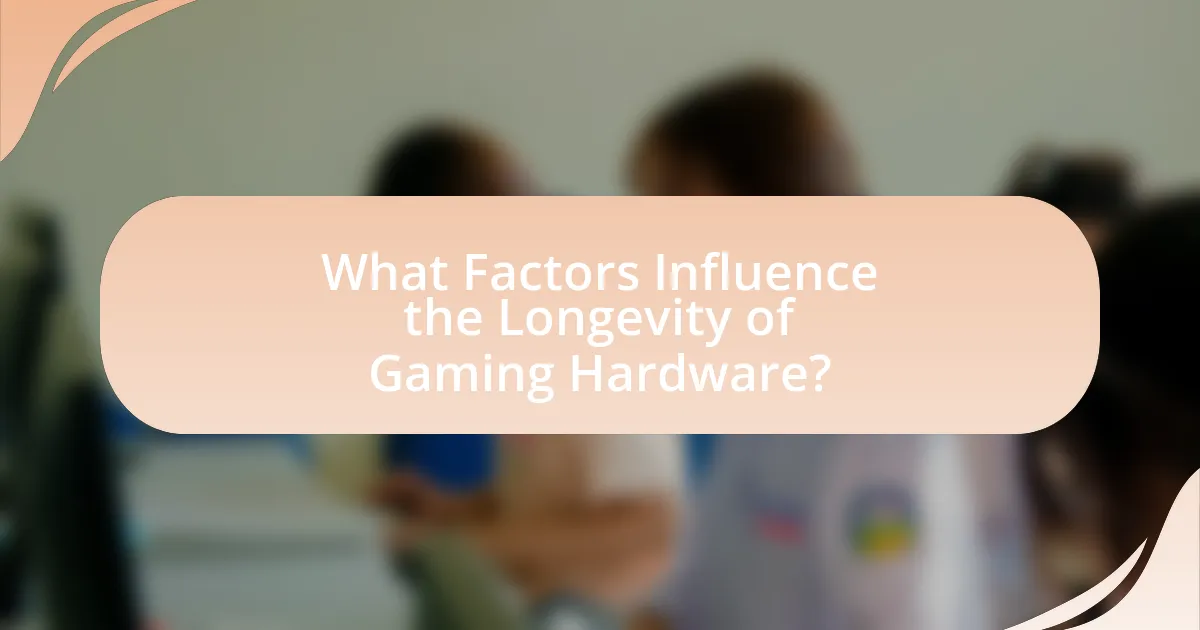The article focuses on the longevity of gaming hardware, examining the various factors that influence its lifespan, including build quality, technological advancements, user maintenance, and environmental conditions. It highlights how advancements in technology can lead to obsolescence, while high-quality materials and effective design contribute to durability. Additionally, the article discusses common signs of aging in gaming hardware, maintenance practices to extend lifespan, and the impact of environmental factors such as temperature and dust accumulation. Gamers are provided with insights on performance degradation, software compatibility, and best practices for maximizing the longevity of their gaming systems.

What Factors Influence the Longevity of Gaming Hardware?
The longevity of gaming hardware is influenced by several key factors, including build quality, technological advancements, and user maintenance. High-quality components, such as durable materials and efficient cooling systems, contribute to a longer lifespan by reducing wear and tear. Technological advancements can render older hardware obsolete, as newer games may require more powerful specifications, thus impacting usability over time. Additionally, regular maintenance, such as cleaning and proper storage, can significantly extend the life of gaming hardware by preventing overheating and physical damage. These factors collectively determine how long gaming hardware remains functional and relevant in the rapidly evolving gaming landscape.
How do technological advancements impact gaming hardware lifespan?
Technological advancements significantly reduce the lifespan of gaming hardware by rapidly introducing new features and capabilities that render older models obsolete. For instance, the release of more powerful graphics processing units (GPUs) and central processing units (CPUs) every few years leads to increased performance expectations, making previous generations less desirable for gamers. According to a report by Jon Peddie Research, the average lifespan of gaming consoles has decreased from around six to seven years to approximately four to five years due to these advancements. As a result, consumers often feel compelled to upgrade to keep up with the latest gaming experiences, thus shortening the effective lifespan of existing hardware.
What role do materials and build quality play in durability?
Materials and build quality are critical factors in determining the durability of gaming hardware. High-quality materials, such as reinforced plastics or metals, enhance resistance to wear, impact, and environmental factors, thereby extending the lifespan of the device. For instance, devices constructed with aluminum chassis are often more durable than those made from cheaper plastics, as aluminum can withstand greater stress and resist bending or breaking. Additionally, superior build quality, characterized by precise assembly and robust design, minimizes the likelihood of mechanical failures, such as loose components or faulty connections. Research indicates that gaming consoles with higher build quality experience fewer malfunctions over time, leading to longer operational life.
How does the design of gaming hardware affect its longevity?
The design of gaming hardware significantly affects its longevity by influencing thermal management, component quality, and upgradeability. Effective thermal management, achieved through proper ventilation and heat dissipation mechanisms, prevents overheating, which can lead to hardware failure over time. For instance, consoles like the PlayStation 4 faced longevity issues due to inadequate cooling designs, resulting in hardware malfunctions. Additionally, the use of high-quality components, such as durable capacitors and robust circuit boards, enhances the lifespan of gaming devices. Research indicates that devices built with premium materials can last significantly longer than those made with cheaper alternatives. Lastly, upgradeability in design allows users to replace or enhance components, extending the device’s usable life. For example, gaming PCs that support easy upgrades can remain relevant for years, while fixed hardware designs may become obsolete more quickly.
What environmental factors can affect gaming hardware lifespan?
Environmental factors that can affect gaming hardware lifespan include temperature, humidity, dust accumulation, and airflow. High temperatures can lead to overheating, which can damage components like the CPU and GPU, reducing their operational lifespan. Humidity can cause corrosion on electronic parts, while excessive dust can obstruct ventilation, leading to overheating. Proper airflow is essential for maintaining optimal operating conditions; inadequate airflow can trap heat and accelerate hardware degradation. Studies have shown that maintaining a stable environment with controlled temperature and humidity can significantly extend the lifespan of electronic devices, including gaming hardware.
How does temperature and humidity influence hardware performance?
Temperature and humidity significantly influence hardware performance by affecting the reliability and efficiency of electronic components. High temperatures can lead to overheating, which may cause thermal throttling, reduced processing speeds, and potential hardware failure. For instance, semiconductor devices typically operate optimally within a temperature range of 0 to 85 degrees Celsius; exceeding this range can result in permanent damage.
Humidity also plays a critical role, as excessive moisture can lead to corrosion of circuit boards and connectors, ultimately impairing functionality. Studies indicate that relative humidity levels above 60% can increase the risk of condensation, which can short-circuit components. Therefore, maintaining optimal temperature and humidity levels is essential for preserving the performance and longevity of gaming hardware.
What is the impact of dust and debris on gaming hardware?
Dust and debris significantly impact gaming hardware by obstructing airflow, leading to overheating and potential hardware failure. When dust accumulates in components like fans and heat sinks, it reduces their efficiency, causing temperatures to rise. For instance, a study by the University of California found that excessive dust buildup can increase operating temperatures by up to 20 degrees Celsius, which can shorten the lifespan of critical components such as the CPU and GPU. Additionally, debris can cause physical damage by interfering with moving parts, leading to malfunctions. Regular cleaning and maintenance are essential to mitigate these risks and ensure optimal performance of gaming hardware.

What Are Common Signs of Aging in Gaming Hardware?
Common signs of aging in gaming hardware include decreased performance, increased heat generation, and physical wear and tear. As gaming hardware ages, components such as the CPU and GPU may struggle to run newer games efficiently, leading to lower frame rates and longer loading times. Additionally, older hardware often produces more heat due to dust accumulation and thermal paste degradation, which can further impact performance and longevity. Physical signs like worn-out ports, damaged cables, or a noisy fan can also indicate that the hardware is nearing the end of its useful life.
How can users identify performance degradation over time?
Users can identify performance degradation over time by monitoring key performance metrics such as frame rates, load times, and system temperatures. Regularly benchmarking these metrics against initial performance levels allows users to detect any significant drops, which may indicate hardware wear or inefficiencies. For instance, a consistent decrease in frame rates during gameplay, compared to baseline measurements taken when the hardware was new, serves as a clear indicator of performance decline. Additionally, tools like software monitoring applications can provide real-time data on CPU and GPU usage, helping users to pinpoint when performance issues arise.
What are the typical symptoms of hardware failure?
Typical symptoms of hardware failure include unexpected crashes, failure to boot, unusual noises, overheating, and performance degradation. These symptoms indicate potential issues with components such as the hard drive, power supply, or cooling system. For instance, a hard drive may produce clicking sounds when it is failing, while overheating can signal inadequate cooling or a malfunctioning fan. Performance degradation often manifests as slow response times or lag, which can be traced back to failing RAM or a deteriorating graphics card. Recognizing these symptoms early can help prevent further damage and data loss.
How does software compatibility change as hardware ages?
As hardware ages, software compatibility typically decreases due to outdated drivers, lack of support for newer software standards, and diminishing performance capabilities. Older hardware may not support the latest operating systems or applications, which often require more advanced features and processing power that aging components cannot provide. For example, as of 2023, many modern games require DirectX 12 or higher, which may not be compatible with older graphics cards that only support DirectX 11 or earlier. Additionally, manufacturers often cease updates for older hardware, leading to security vulnerabilities and incompatibility with newer software releases. This trend is evident in the gaming industry, where titles released in recent years frequently specify minimum hardware requirements that exclude older systems.
What maintenance practices can extend the life of gaming hardware?
Regular cleaning, proper ventilation, and software updates are essential maintenance practices that can significantly extend the life of gaming hardware. Cleaning components like fans and vents prevents dust buildup, which can lead to overheating and hardware failure. Ensuring adequate airflow around the gaming system helps maintain optimal operating temperatures, reducing thermal stress on components. Additionally, keeping software and drivers updated enhances performance and compatibility, which can prevent issues that may arise from outdated systems. These practices are supported by industry standards that emphasize the importance of thermal management and regular maintenance for electronic devices.
How often should hardware be cleaned and serviced?
Hardware should be cleaned and serviced every three to six months. Regular cleaning prevents dust buildup, which can lead to overheating and reduced performance. Additionally, servicing ensures that components are functioning optimally and can extend the lifespan of the hardware. According to a study by the National Institute of Standards and Technology, maintaining clean hardware can improve efficiency by up to 30%, highlighting the importance of routine maintenance.
What upgrades can be made to improve longevity?
Upgrades that can be made to improve the longevity of gaming hardware include enhancing cooling systems, upgrading power supplies, and using high-quality components. Improved cooling systems, such as adding more efficient fans or liquid cooling solutions, help maintain optimal operating temperatures, which can prevent overheating and extend the lifespan of components. Upgrading to a higher wattage power supply can provide more stable power delivery, reducing the risk of damage from power fluctuations. Additionally, using high-quality components, such as solid-state drives instead of traditional hard drives, can lead to better performance and durability, as SSDs have no moving parts and are less prone to mechanical failure. These upgrades are supported by industry standards that emphasize the importance of thermal management and power stability in prolonging hardware life.

What Should Gamers Expect from Their Hardware Over Time?
Gamers should expect their hardware to experience performance degradation and obsolescence over time due to advancements in technology and increasing software demands. As new games are released, they often require more powerful hardware specifications, which can render older systems inadequate for optimal performance. For instance, the average lifespan of a gaming console is around 5 to 7 years, during which time significant improvements in graphics and processing power are made, as seen with the transition from PlayStation 4 to PlayStation 5. Additionally, components such as graphics cards and CPUs may become less effective as newer models are introduced, leading to a decline in gaming experience. Therefore, gamers should plan for upgrades or replacements to maintain competitive performance and enjoy the latest gaming experiences.
How does the gaming experience evolve with aging hardware?
The gaming experience deteriorates with aging hardware due to decreased performance and compatibility issues. As hardware ages, its processing power, graphics capabilities, and memory become insufficient for newer games, leading to lower frame rates, longer load times, and reduced visual fidelity. For instance, a study by Jon Peddie Research indicates that graphics performance can decline significantly as hardware becomes outdated, impacting the overall gaming experience. Additionally, older hardware may struggle to run modern game engines and software updates, resulting in crashes or inability to access new features. This evolution highlights the necessity for gamers to upgrade their hardware periodically to maintain an optimal gaming experience.
What performance benchmarks should gamers monitor?
Gamers should monitor frame rate (FPS), latency, and temperature as key performance benchmarks. Frame rate indicates how smoothly a game runs, with higher FPS providing a better experience; for instance, 60 FPS is generally considered the minimum for smooth gameplay. Latency, or input lag, affects responsiveness, with lower latency leading to quicker reactions in competitive gaming; a latency of under 20 milliseconds is ideal. Temperature is crucial for hardware longevity, as excessive heat can lead to throttling or damage; maintaining temperatures below 85 degrees Celsius for GPUs is recommended to ensure optimal performance and lifespan.
How can gamers adapt their gaming habits as hardware ages?
Gamers can adapt their gaming habits as hardware ages by optimizing game settings, prioritizing less demanding titles, and utilizing cloud gaming services. Optimizing game settings, such as reducing resolution and turning off graphical enhancements, can significantly improve performance on older hardware. Prioritizing less demanding titles allows gamers to continue enjoying new experiences without overloading aging systems. Additionally, cloud gaming services, which offload processing to remote servers, enable gamers to play high-quality games without relying on local hardware capabilities. These strategies are effective as they directly address the limitations imposed by aging hardware while maintaining an enjoyable gaming experience.
What are the best practices for maximizing gaming hardware lifespan?
To maximize gaming hardware lifespan, users should maintain optimal cooling, regularly clean components, and ensure proper power supply management. Optimal cooling prevents overheating, which can damage sensitive components; for instance, maintaining a temperature below 80°C can significantly extend the lifespan of CPUs and GPUs. Regular cleaning of dust from fans and heatsinks enhances airflow and cooling efficiency, reducing the risk of thermal throttling. Additionally, using a high-quality power supply with stable voltage protects hardware from power surges and fluctuations, which can lead to premature failure. Following these practices can effectively prolong the operational life of gaming hardware.
How can proper usage and care prolong hardware life?
Proper usage and care can significantly prolong hardware life by minimizing wear and tear, preventing overheating, and ensuring optimal performance. Regular maintenance, such as cleaning dust from components and ensuring proper ventilation, reduces the risk of overheating, which is a leading cause of hardware failure. Additionally, using hardware within recommended specifications, such as voltage and temperature limits, prevents damage from overuse. Studies indicate that devices maintained with proper care can last up to 50% longer than those that are neglected, highlighting the importance of responsible usage and maintenance practices.
What are the most effective troubleshooting tips for aging hardware?
The most effective troubleshooting tips for aging hardware include performing regular maintenance, checking for overheating, updating drivers, and testing components individually. Regular maintenance, such as cleaning dust from fans and vents, can prevent overheating, which is a common issue in aging hardware. Overheating can lead to performance degradation and hardware failure. Updating drivers ensures that the hardware operates with the latest optimizations and fixes, which can enhance performance and stability. Testing components individually, such as RAM and hard drives, can help identify failing parts, allowing for targeted replacements rather than replacing entire systems. These strategies are supported by industry practices that emphasize proactive care and component testing to extend the lifespan of aging hardware.